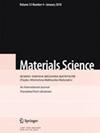受到硫酸钠侵蚀的珍珠岩砂浆的力学行为和耐久性
IF 0.7
4区 材料科学
Q4 MATERIALS SCIENCE, MULTIDISCIPLINARY
引用次数: 0
摘要
这项研究的目的是收集更多有关珍珠岩对材料的机械性能和抗化学侵蚀能力的影响的信息。研究考察了以水泥添加物形式加入珍珠岩的各种组合。为了与普通水泥进行比较,使用了 10%、15%、20%、25% 和 30% 五种不同的水泥珍珠岩粉替代率。研究结果表明,粉末珍珠岩中的石灰、二氧化硅和氧化铝之间的相互作用会形成多种水合物,如水合硅酸钙、水合铝酸钙和水合明胶石。在评估这种材料的水胶凝性时,我们发现氯化物、二氧化碳和化学侵蚀等外部侵蚀会损害混凝土的物理和机械性能,影响其长期耐久性。不过,像 pelite 这样的天然胶凝剂对灰泥的耐久性有积极的影响,可以抵御硫酸盐的侵蚀。测试结果表明,试样没有出现明显的降解现象,这表明溶液中的硫酸根离子不会对基于珍珠岩的砂浆产生不利影响。人们越来越倾向于使用生产成本低于水泥的矿物添加剂。因此,最佳混合物被确定为含 25% 珍珠岩的混合物。不过,珍珠岩含量高达 20% 的水泥浆和灰泥也表现出令人满意的物理和机械性能,可与不含珍珠岩的材料相媲美。对与水泥一起使用的珍珠岩材料的调查表明,可持续混凝土具有潜力。实验结果表明,来自马格尼亚的天然珍珠岩粉末可被视为一种良好的胶凝材料,适合作为水泥生产中的矿物掺合料。本文章由计算机程序翻译,如有差异,请以英文原文为准。
Mechanical Behavior and Durability of Perlite Based Mortar Exposed to Sodium Sulfate Attack
The objective of this study is to gather additional on the impact of perlite on both the mechanical properties and resistance to chemical attacks of materials. Various combinations ,incorporating perlite in the form of cement additions, were examined. Five different substitution rates of 10 %, 15 %, 20 %, 25 %,and 30 % of cement with powder perlite were utilized for comparison with plain cement. The findings indicate that the interaction between lime,silica,and alumina in powder perlite results in the formation of several hydrates, such as calcium silicate hydrate, hydrated calcium aluminates,and hydrated gelhenite.Our research focuses on the development of natural perlite from maghnia as a potentially pozzolanic supplementary cementing material. In evaluating the pozzolanicity of this material, it was observed that external aggressions, such as chlorides, CO2, and chemical attacks, can compromise the physical and mechanical properties of concrete,affecting its long-term durability. However,natural pozzolans like pelite exhibit a positive influence on the durability of mortars against sulphate attacks. Test results revealed specimens with no apparent degradation, indicating that sulphate ions in the solution did not adversely affect perlite-based mortars. There is a growing preference for mineral additives with lower production costs than cement. Consequently, the optimal mixture was determined to be one containing 25 % perlite. However, cement pastes and mortars incorporating up to 20 % perlite demonstrated satisfactory physical and mechanical properties, comparable to materials without perlite. The investigation into the perlite materials used in conjunction with cement suggests the potential for sustainable concrete. Experimental results indicate that natural perlite powder from Maghnia can be considered a good pozzolanic material, suitable as a mineral admixture in cement production.
求助全文
通过发布文献求助,成功后即可免费获取论文全文。
去求助
来源期刊

Materials Science
工程技术-材料科学:综合
CiteScore
1.60
自引率
44.40%
发文量
63
审稿时长
4-8 weeks
期刊介绍:
Materials Science reports on current research into such problems as cracking, fatigue and fracture, especially in active environments as well as corrosion and anticorrosion protection of structural metallic and polymer materials, and the development of new materials.
 求助内容:
求助内容: 应助结果提醒方式:
应助结果提醒方式:


